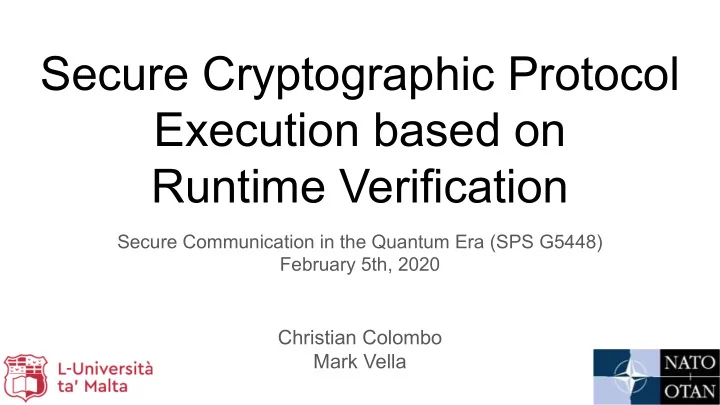

Secure Cryptographic Protocol Execution based on Runtime Verification Secure Communication in the Quantum Era (SPS G5448) February 5th, 2020 Christian Colombo Mark Vella
Cryptographic Protocols Design Proofs to validate design against threat models Implementation Difficult to make it fully secure… So many things can go wrong!
Levels of abstraction of security threats The protocol implementation might deviate from (High level) Wrong protocol implementation the verified (theoretical) design Medium level threats Malware, Data leaks, etc Arithmetic overflows, undefined downcasts, Low level threats and invalid pointer references Can hardware be trusted? Hardware Side Channel attacks?
It is difficult to make implementation fully secure… but we can raise the bar as much as possible.
Our strategy Isolate!
Design of architecture
Our strategy Isolate! Monitor!
Monitor code while executing (High level) Monitor for data leaks (medium level)
Preliminary case study Web server Elliptic Curve Diffie-Hellman Exchange (ECDHE) Firefox implementation (C code)
Preliminary implementation Setup using Binary-level instrumentation Web server Binary instrumentation Firefox implementation (C code)
Preliminary implementation Setup using Binary-level instrumentation Through which monitors can gain visibility Web server Runtime Binary instrumentation Verification Firefox implementation (C code)
Properties verified (High level) on ECDHE Digital certificate verification is done (in order to authenticate public keys sent by peers)
Properties verified (High level) on ECDHE Validation of remote peer's public key on each exchange is done (unless the session is aborted)
Properties verified (High level) on ECDHE Once master secret is established, private keys should be scrubbed from memory (to limit the impact of memory leak attacks such as Heartbleed, irrespective of whether the session is aborted)
Feasibility study of approach Is the approach possible for a realistic code base? Is the approach feasible in terms of overheads? Used the Firefox case study on top 100 Alexa sites
Web server Feasibility study Runtime Binary instrumentation Verification Firefox implementation (C code)
Overheads measurement
Overheads measurement 0.05 ms per page
Lessons learnt Good start with promising results - approach seems feasible Beware: Program comprehension is required , both for setting up function hooks as well as to enable individual TLS session monitoring Real-world code tends to be written in a manner to favor efficient execution rather than monitorability (eg, was difficult to keep track of particular sessions on the server)
Secure Communication in the Quantum Era NATO Science for Peace and Security Programme, Project no. G5448 Partners: Slovakia - Slovak University of Technology Malta - University of Malta Spain - Universidad Rey Juan Carlos US - Florida Atlantic University http://re-search.info/
Recommend
More recommend